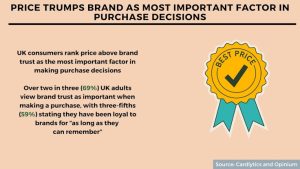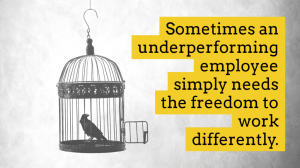Purchase decisions, brand identity, tone: 5 interesting stats to start your week
Price trumps brand as most important factor in purchase decisions
UK consumers rank price above brand trust as the most important factor in making purchase decisions.
Over two in three (69%) UK adults view brand trust as important when making a purchase, with three-fifths (59%) stating they have been loyal to brands for “as long as they can remember”.
The research is based on the spending habits of 22 million UK bank accounts, as well as a poll of 2,000 consumers. The study focuses on three specific sectors – retail, hospitality and travel.
In the restaurant sector, over half (54%) of adults choose to return to restaurants they have visited before over trying new alternatives. Despite this, a similar number (54%) of consumers say they are more likely to visit a new restaurant if it offers a discount voucher.
Cost is the key factor in the grocery sector, with two-thirds (64%) of respondents naming affordability as the most important factor in deciding where to shop. Loyalty factors are also a significant factor alongside affordability, with more than three in five (61%) stating they are more likely to visit a supermarket if it offers a loyalty or rewards system.
Trust in brand is a particularly significant factor for consumers in the holiday sector, with 69% stating this is an important factor when making their purchase decision.
Source: Cardlytics and Opinium
Over four in five C-suite leaders struggle with maintaining consistent brand identity
 Over four in five (81%) C-suite leaders struggle to maintain a consistent brand identity across diverse markets, according to research from Contentful and VML.
Over four in five (81%) C-suite leaders struggle to maintain a consistent brand identity across diverse markets, according to research from Contentful and VML.
The research surveyed over 1,000 C-suite respondents across the US, UK, Germany and the Netherlands. When it comes to these leaders delivering omnichannel content, 83% report communication breakdown as being a major obstacle.
Leaders are also struggling to convey the effectiveness of their communications, the research finds, with 84% of C-suite executives stating they find it difficult to quantify content’s impact. Cultural differences within the organisation are also negatively impacting marketing effectiveness, with four in five (80%) leaders finding this difficult.
Source: Contentful and VML
Significant majority of consumers expect finance communications to be formal
 Most consumers (83%) believe brands that work in the finance industry should always use a formal tone of voice in email communications. A similar proportion (83%) of consumers also think health brands should use a formal tone in communications.
Most consumers (83%) believe brands that work in the finance industry should always use a formal tone of voice in email communications. A similar proportion (83%) of consumers also think health brands should use a formal tone in communications.
By contrast, just 38% of consumers think retail brands always need to be formal, while half (50%) think tech brands need to be formal.
The results found that, overall, 65% of participants believe brand email communications should always be formal. This is particularly high among baby-boomers, 76% of whom think brand communications should be formal.
Just 2% of consumers think using Gen Z slang in emails is professional, with 20% classing it as “modern” and 11% classing it as “risky”.
Source: Exclaimer
Commercial radio continues to capture growing share of listeners
 Commercial radio has increased its share of listening hours both year-on-year and quarter-on-quarter, driven by growth from radio networks Global and Bauer.
Commercial radio has increased its share of listening hours both year-on-year and quarter-on-quarter, driven by growth from radio networks Global and Bauer.
According to Radio Joint Audience Research (RAJAR), commercial radio had a 55% share of total listening hours for the 12 weeks ending 23 June 2024. This was up from 54.2% in Q1 and 54.5% during the same period in 2023.
RAJAR is the official body for measuring radio audiences in the UK and is jointly owned by the BBC and industry body Radiocentre.
Across the UK, 40.5 million adults over the age of 15 tuned into commercial radio each week, an increase from 39.1 million on last year. This figure represents the number of UK adults who listen to a station for at least five minutes each week.
Last quarter, online listening overtook FM and AM platforms for the first time in history. In Q2 this trend continued, accounting for 28.1% of all listening, up from 24.9% a year ago. Comparatively, AM and FM listening continues to decline, with a share of 26.3% across all radio, down from 31.4% a year ago.
Source: Radio Joint Audience Research (RAJAR)
Average Brit to spend almost £600 this Christmas
 The average British consumer expects to spend £593.90 on core Christmas-related products and activity – including food, gifts, decorations, socialising and travelling – during the 2024 festive period.
The average British consumer expects to spend £593.90 on core Christmas-related products and activity – including food, gifts, decorations, socialising and travelling – during the 2024 festive period.
Perhaps unsurprisingly, parents expect to spend considerably more (£654.40) than non-parents (£397.90).
The majority (55%) of UK adults expect to spend the biggest proportion of their Christmas budget on gifts for others, followed by food and drink (18%), travel (6%), gifts for themselves (4%), socialising (4%) and decorations (2%).
Almost a third (31%) of all consumers expect to still be shopping during December, while 43% plan to have finished their shopping before Black Friday. Younger generations are most likely to take advantage of the Black Friday sales, with 82% of 18 to 24s and 75% of 25 to 34s planning to spend at least a quarter of their budget during this time.









